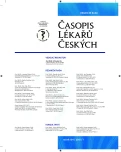Contribution to the History of Pharmacology
(The Late Antique Period)
Authors:
Drahomíra Tesařová
Authors‘ workplace:
Vysoká škola zdravotníctva a sociálnej práce sv. Alžbety v Bratislave, n. o. (detašované pracoviště Praha)
Published in:
Čas. Lék. čes. 2015; 154: 28-31
Category:
History of Medicine
Overview
Pharmacological literature in the Late Antique period followed the Roman tradition and widely used Scribonius Largus and excerpts from the writings of Pliny the Elder. Literature was created both in the western part of the Roman Empire and in North Africa in Carthage. Manuals have been written about medicinal plants (Herbarius of Pseudo-Apuleius, De herba vettonica of Pseudo-Musa), for drugs obtained from the animal kingdom (Liber medicinae of Sextus Placitus) or documents containing both (De medicina of Cassius Felix, De medicamentis of Marcellus Empiricus). The contribution of this literature is the mediation of ancient knowledge into the Middle Ages.
Keywords:
pharmacology – the history of pharmacology – Pseudo-Apuleius – Pseudo-Musa – Sextus Placitus – Vindicianus – Cassius Felix – Marcellus Empiricus
Sources
1. Meyer-Steineg Th, Sudhoff K. Geschichte der Medizin im Überblick mit Abbildungen. Jena: Verlag von Gustav Fischer 1921; 167n.
2. Corpus medicorum Latinorum IV – Antonii Musae De herba vettonica liber, Pseudoapulei Herbarius, Anonymi de taxone liber, Sexti Placiti liber medicinae ex animalibus etc. Howald E, Sigerist HE. (ed.) Lipsiae: Teubner 1927.
3. Corpus medicorum Latinorum IV. op. cit. Praefatio s. 23.
4. Herba millefolium = Achillea millefolium (= Řebříček obecný) – pozn. autora.
5. Pseudoapulei Herbarius, In: Corpus medicorum Latinorum IV. Howald E, Sigerist HE. (ed.) Lipsiae: Teubner 1927; 159–160. Český překlad je vlastní.
6. viz pozn. 5.
7. Meyer-Steineg Th, Sudhoff K. Geschichte der Medizin im Überblick mit Abbildungen. Jena: Verlag von Gustav Fischer 1921; 169.
8. Corpus medicorum Latinorum IV. op. cit. Praefatio; 19.
9. Corpus medicorum Latinorum IV. op. cit. Praefatio; 21.
10. Pův. vettonica podle jména Vettonů, kteří žili na úpatí Pyrenejí a této rostliny užívali (= bukvice lékařská – pozn. autora).
11. Antonii Musae De herba vettonica liber. In: Corpus medicorum Latinorum IV. Howald E, Sigerist HE. (ed.) Lipsiae: Teubner 1927; 6. Český překlad je vlastní.
12. Georges KE. Ausführliches lateinisch-deutsches Handwörtebuch.6. vyd. Leipzig: Hahn’sche Verlag 1869. Díl I. 2612 s., s. v. drachma.
13. viz pozn. 2.
14. „ …bestiolam hanc quadrupedem, quam nos taxonem adpellamus, quidam etiam melem dicunt,…“ – toto čtyřnohé zvířátko nazýváme „taxo“, jiní také „mel“,… (cit. podle Anonymi de taxone liber. In: Corpus medicorum Latinorum IV. Howald E, Sigerist HE. (ed.) Lipsiae: Teubner 1927, s. 229. Český překlad je vlastní.
15. Anonymi de taxone liber. In: Corpus medicorum Latinorum IV. Howald E, Sigerist HE. (ed.) Lipsiae: Teubner 1927; 229–232. Český překlad je vlastní.
16. Sexti Placiti liber medicinae ex animalibus etc. In: Corpus medicorum Latinorum IV. Howald E, Sigerist HE. (ed.) Lipsiae: Teubner 1927; 266. Český překlad je vlastní.
17. Sexti Placiti liber medicinae ex animalibus etc. In: Corpus medicorum Latinorum IV. Howald E, Sigerist HE. (ed.) Lipsiae: Teubner 1927; 267. Český překlad je vlastní.
18. Corpus medicorum Latinorum IV. op. cit. Praefatio; 21.
19. Epistula Vindiciani comitis archiatrorum ad Valentinianum imperatorem. In: Marcellus. De medicamentis liber. Lipsiae: G. Helmreich 1889; 21–25.
20. Epistula Vindiciani comitis archiatrorum ad Valentinianum imperatorem. In: Marcellus. De medicamentis liber. Lipsiae: G. Helmreich 1889; 25. Překlad je vlastní.
21. Šimon F. Historia medicinae antiquae. Príspevky k dejinám antickej medicíny. Košice: Univerzita P. J. Šafárika 2009; 24.
22. Tento citát i úryvky níže uvedené pocházejí z knihy Cassius Felix. De la médicine. Paris: Société d’édition „Les belles lettres“ 2002.
23. Meyer-Steineg Th, Sudhoff K. Geschichte der Medizin im Überblick mit Abbildungen. Jena: Verlag von Gustav Fischer 1921; 171.
24. Marcellus. De medicamentis liber. Lipsiae: G. Helmreich 1889. Překlad je vlastní.
25. Název této rostliny pochází od Římanů, kteří si jí cenili také jako afrozidiaka, a pojmenovali ji proto „Satyrova rostlina“ (pozn. autora).
26. Cyathus = 1/8 sextarii (podle Marcellus. De medicamentis liber. Lipsiae: G. Helmreich 1889; 3).
27. Denarius = drachma (podle Marcellus. De medicamentis liber. Lipsiae: G. Helmreich 1889; 3).
28. Marcellus. De medicamentis liber. Lipsiae: G. Helmreich 1889, 414 s. Překlad je vlastní.
Labels
Addictology Allergology and clinical immunology Angiology Audiology Clinical biochemistry Dermatology & STDs Paediatric gastroenterology Paediatric surgery Paediatric cardiology Paediatric neurology Paediatric ENT Paediatric psychiatry Paediatric rheumatology Diabetology Pharmacy Vascular surgery Pain management Dental HygienistArticle was published in
Journal of Czech Physicians

Most read in this issue
- Anal fissure
- Subcutaneous rehydration in patients in terminal phase of dementia
- Indoleamine 2,3-dioxygenase in oncology and psychiatry
- With children against obesity
